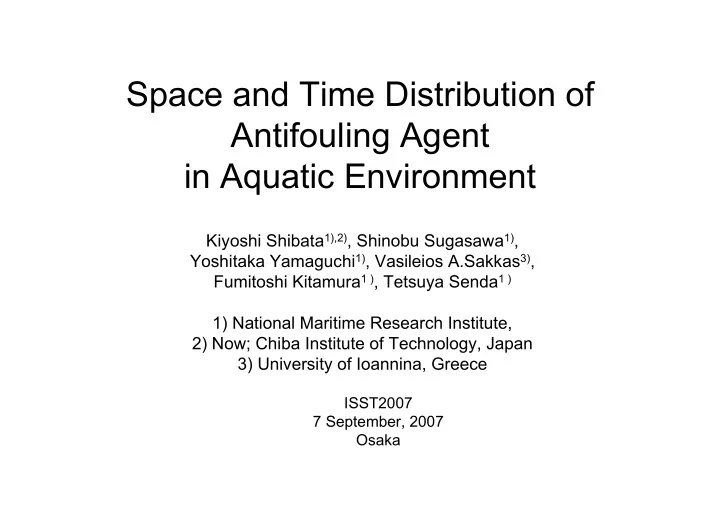

Space and Time Distribution of Antifouling Agent in Aquatic Environment Kiyoshi Shibata 1),2) , Shinobu Sugasawa 1) , Yoshitaka Yamaguchi 1) , Vasileios A.Sakkas 3) , Fumitoshi Kitamura 1 ) , Tetsuya Senda 1 ) 1) National Maritime Research Institute, 2) Now; Chiba Institute of Technology, Japan 3) University of Ioannina, Greece ISST2007 7 September, 2007 Osaka
Background • Some of the “alternative” antifouling agents are toxic, and their actual degradation performance in the environment is still not clear. • It is a general practice to compare PEC and PNEC of the substance to evaluate environmental risk. • The PEC calculation is made by simulating all relating fate processes. • The photo-degradation is an unique one among the fate processes..
Background • The light intensity changes drastically with time or depth. • If the anti-faulant is sensitive to light, its concentration changes with time and location. • The environmental risk can vary with time and space.
Purpose • To investigate the possibility of concentration fluctuation/change. • A simple 2D unsteady state model has been developed, simulating the leaching, diffusion and degradation process of the antifouling agent in the environment.
Two dimensional unsteady state model 3m 25m Photodegradation Leaching Diffusion
Release Rate dC/d t = k ( C sat - C ) 1000 1000 800 800 濃度(ppb) 600 濃度(ppb) 600 0rpm 400 400 0rpm 30rpm 30rpm 60rpm 200 60rpm 200 180rpm 180rpm 0 0 0 10 20 30 0 10 20 30 時間(hr) 時間(hr)
Diffusion • Diffusion Jx = Deff,x d C /d x Jz = Deff,z d C /d z Jx :Flux in horizontal direction , Deff,x : Effective diffusion constant in horizontal direction x : horizontal distance Jz : Flux in vertical direction Deff,z: Effective diffusion constant in vertical direction z : vertical distance
Photodegradation Model Photodegradation Kinetics - First order kinetics d C /d t =- k C C: Concentration , t: Time , k:Rate Constant - Rate constant : proportional to sunlight k = α I I : Light irradiation intensity (Permeability, Wave length, Suspended/Dissolved Matter, Latitude, Season, Time, Weather ) K.Shibata NMRI
Sun Light Irradiation Intensity I Z=0 =0 0 < t < 6 I Z=0 = I Z=0, t=12 [1 - cos{ π ( t - 6 ) / 6}]/2 6 < t < 18 I Z=0 =0 18 < t < 24 Dimensionless Sun Light 1.2 1 Intensity (-) 0.8 0.6 0.4 0.2 0 0 6 12 18 24 Time (hour)
Decrease in light irradiation intensity in water column 3 Conc. Of Chlorophyll- α 400nm Log[Intensity/(10-6W/cm2/nm)] 500nm (10 -6 g/L) 2 600nm 21.5 700nm @Tokyo Bay 0.66 1 @ Sagami Bay 0.0813 @Pacific Ocean 0 after Kishino(1994) -1 -2 0 20 40 60 80 100 120 I = I 0 × 10 - β Z Depth (m) K.Shibata NMRI
Concentration Change along Time and Space 1m from coating surface 20 Z=0.05m Concentration (mg/m3) Z=1.45m 15 Z=2.95m 10 5 0 0 50 100 150 200 Time (hr)
Concentration Change along Time and Space 20 20 Concnetration (mg/m3) Concentration (mg/m3) Z=0.05m Z=0.05m Z=1.45m Z=1.45m 15 15 Z=2.95m Z=2.95m 10 10 5 5 0 0 0 50 100 150 200 0 50 100 150 200 TIme (hr) Time (hr) 5m from coating surface 20m from coating surface
Effects of the Diffusion Coefficients Concentration Change in the day 7 at the point 1m from the painted surface 50 50 Concentration (mg/m3) Concnetration (mg/m3) 0.05 0.05 40 40 0.85 0.85 30 1.75 30 1.75 2.65 2.65 20 20 10 10 0 0 0 6 12 18 24 0 6 12 18 24 Time (hr) Time (hr) Deff,x :3.6x10-2 m2/hr, Deff,x :3.6x10-3 m2/hr Deff,z : 3.6x10-4m2/hr Deff,z : 3.6x10-5m2/hr
Discussions • Importance of the sensitivity of the photolysis rate to the depth in water column. • It might be worth while to examine the concentration distribution along the depth of water column , or at night.
Discussions / Questions • PEC ; How to make average? The highest concentration in a short time period and narrow space, or averaged one in a long time period and large area? • What is adequate or proper end point to assess the environmental risk?
Conclusion • A simple model to predict the concentration distribution of antifouling agent in aquatic environment was developed to look into the effect of photodegradation on the concentration distribution. • The model clearly indicats that the effect of the change in sun light irradiation intensity and penetration of the light in the water column is significant in accumulation of the antifouling agent in water column. The concentration may be seriously high at deep water or at night. • If the concentration distribution is steep and changing rapidly, special care has to be paid to select the end point for the environmental risk assessment.
Future Task • Evaluation of the parameters • Introduction of water flow model • Evaluation of hydrolysis and biolysis, as well as adsorption, as fate processes • Discussion on the end point
Acknowledgement • Ministry of Environment • Japanese Society for the Promotion of Science • Chugoku Marine Paint
Apologize by KS Any questions and comments, to Kiyoshi SHIBATA of Chiba Institute of Technology kyshibt@sky.it-chiba.ac.jp
Recommend
More recommend